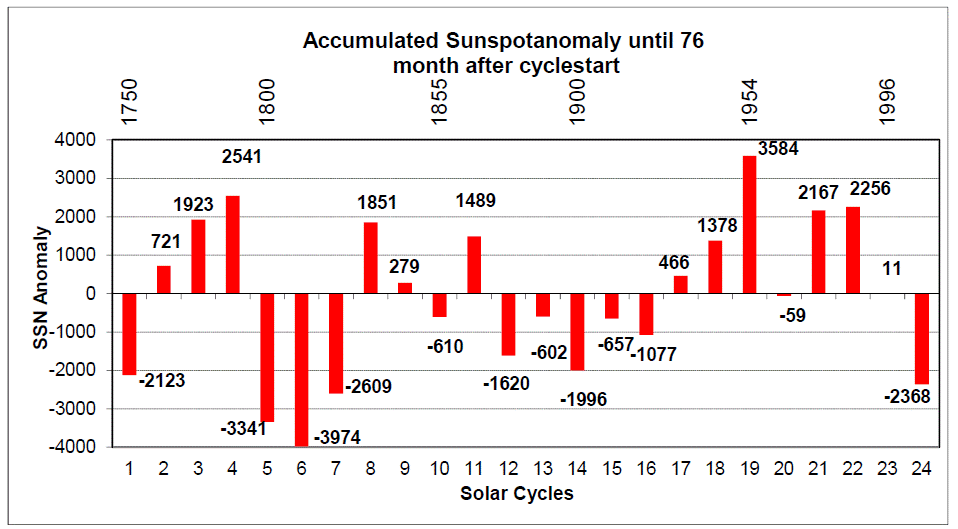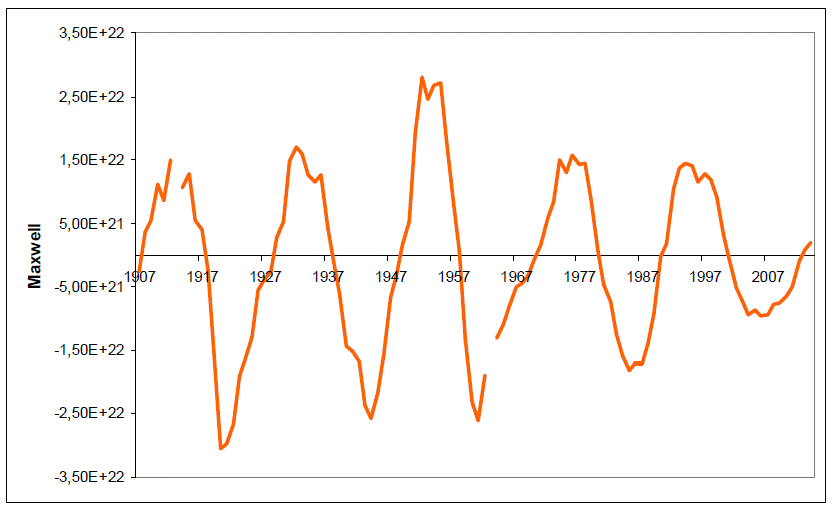Although over the last 2 years the current solar cycle saw some activity, it recently has quieted down considerably and it continues on the path to being one of the quietest since observations began over 350 years ago. -PG
===============================
The Sun In March 2015
By Frank Bosse and Fritz Vahrenholt
Translated, edited by P Gosselin
Last month our sun gave a really sluggish impression. The sunspot number (SSN) was only 38.4: only 46% of what is normal at this time into a cycle for all the cycles observed since 1750.

Fig. 1: The current solar cycle 24 compared to the mean of all previous cycles (blue) and to solar cycle no. 1, 1755-1766, (black).
Comparing the individual cycles to each other further confirms that the current cycle is a quiet one compared to those we saw in the second half of the last century:

Fig. 2: Comparison of all the solar cycles. The figures represent the summed SSN deviation from the mean for first 76 months into the cycle, for all cycles. The current cycle so far is the 4th most inactive since observations began in 1750.
The current cycle is the quietest since solar cycle no. 7, which occurred around 1830. When it comes to the question of why, the polar magnetic fields of the sun are decisive. We reported on this in detail (see “The sun in Jaunary 2014 and news about the polar solar field“). Its been a few months since the last data recording and today we are 2 years past the suspected smoothed maximum. The polar fields went through the zero-point already in March 2013, as can be seen from the data from the Wilcox Solar Observatory (WSO). There it can be seen that especially the north polar field is still barely established.
How does that compare historically?
Recording of data for the polar fields first began in the early 1970s, which means the time period is still too short to allow real comparisons to be made. But in a paper from 2012 the authors led by Andrés Muñoz-Jaramillo used the observations of solar flares made since 1900 as a proxy for the sun’s polar fields. The lead author of the paper kindly agreed to share the data with the authors of this article and so it is possible to compare the current relationships with the long-term series:

Fig. 3: The relative strength of polar solar fields since 1900.
Here it is clear to see that in the second year past the cycle peak, the polar fields have never been so weak. Consider that the strength of the sun’s polar fields during the solar sunspot minimum is a decisive indicator for the activity of the next solar cycle. A very recent paper by Robert Cameron and Manfred Schüssler confirms this.
We only need to be patient a little longer and to pay further attention to the ongoing development of the sun’s polar fields in order to attempt a forecast. The preliminary indications do point to a low level of activity and thus perhaps an even weaker solar cycle 25 beginning around 2022.





The signals for a weak subsequent solar cycle are getting stronger, which means a protracted solar minimum. And when we look back at history, we all know that that means climatically. Don’t by any ice-covered coastal Greenland property just yet!
Yo! Pierre,
Something funky going on with your blog site.
Display is all over the place. !
or , I’ve had too much to drink 😉
I think you bin hacked..
I keep going to
https://notrickszone.com/#sthash.Vq8hKPaa.dpbs
even when I use a different browser.
Sorry about that…formatting error. Should be fixed now.
[…] Full post […]
We are very fortunate the sun is supplying at least one free test. If Cycle 24 had been like 22 and 23 it would be difficult to determine what effect one cycle has on climate. One weak cycle probably won’t be enough but it is a start.
If we are fortunate enough to have an even weaker Cycle 25 we will learn much more. And a third weak cycle should settle the question. Don’t worry, many questions would remain. We won’t run out.
And we have some great tools for studying the Sun now. This is the Golden Era for solar physicists.
[…] on 12 March, provided another way to look at Solar Cycle 24. It is worth sharing. They posted “The Sun In March 2015” on the Notrickszone.com website. They begin by […]